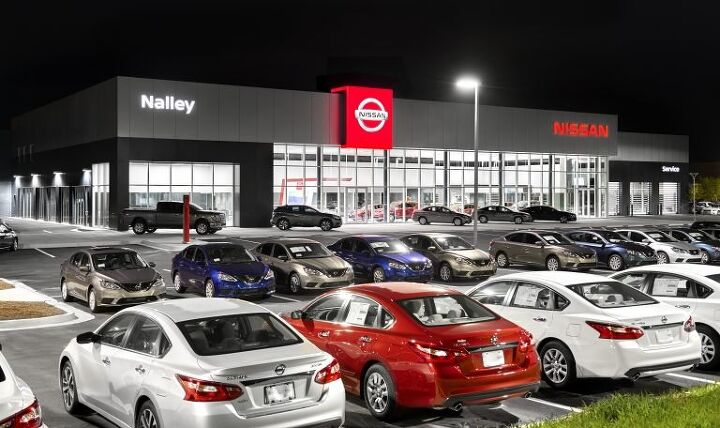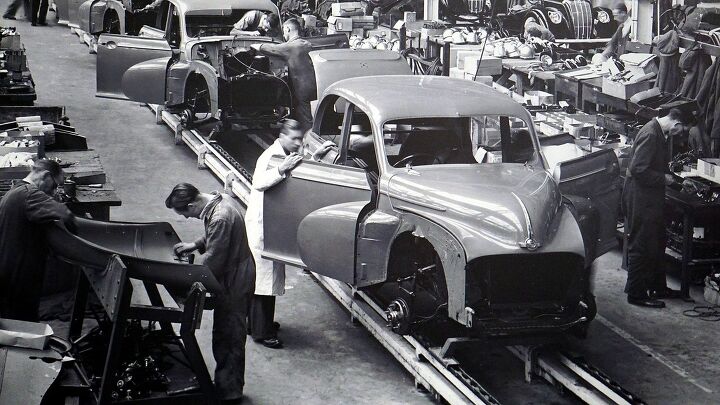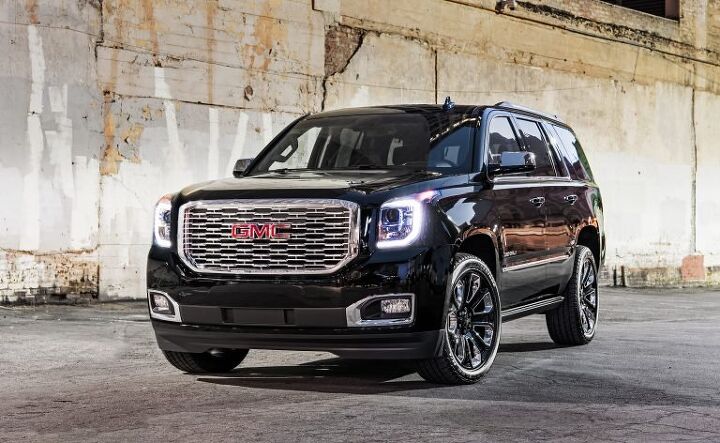#AutomotiveMarket
Study Claims Gen Z Doesn't Like Buying Cars
Younger drivers have reportedly had it with the dealership experience, with Gen Z even more disenfranchised than Millennials. Though it’s difficult to imagine anybody visiting a showroom within the last 12 months having any other reaction. Incentives are down, prices are up, and there’s a good chance whatever you wanted to buy isn’t going to be on the lot anyway. Someone saying they had an exemplary dealer experience is becoming about as common as people claiming they enjoy going to the DMV.
However, CDK Global Inc. still opted to conduct a survey in the hopes of determining just how much less tolerant younger shoppers might be compared to older generations. The takeaway probably isn’t going to shock you, even if the sheer volume of first-time buyers that don’t care for dealerships might.
Report: U.S. Automotive Market in Rough Shape
The U.S. light-vehicle market doesn’t appear to be in the best health. While many automakers now opt against issuing monthly sales reports, those that still do are posting some pretty brutal numbers.
This does not bode well for an industry that seemed pretty certain that 2022 would be its recovery year. However, it is on-brand with the slew of announcements made by manufacturers warning about supply constraints and an inability to manufacture at scale. There has also been a growing sense that some consumers may be shunning vehicles that have spent the last several months trading well above what seems rational. Wholesale pricing actually declined by roughly 6 percent since the January record. Though you may not see that represented on dealer lots or even have noticed if it was because last month still saw transactions averaging 14 percent higher than they were last year.
How Shanghai Lockdowns Are Changing the Auto Industry
While the semiconductor shortage was long considered the excuse par excellence for why the automotive sector couldn’t produce enough vehicles during the pandemic, some manufacturers have begun pivoting to blaming supply chains that have been stymied by Chinese lockdowns. Toyota is probably the best-known example. But the matter is hardly limited to a singular automaker and market analysts have already been sounding the alarm bell that strict COVID-19 restrictions in Asia will effectively guarantee prolonged industrial hardship around the globe.
Back in April, Shenzhen was emerging from a month-long lockdown. However, the resulting downtime severely diminished the tech hub’s output which exacerbated global component shortages. While Chinese state-run media claimed regional factories maintained full-scale production during the period, the reality was quite a bit different. Meanwhile, Shanghai has remained under harsh restrictions since March and more look to be on the horizon. As an important industrial center and the world’s busiest port by far, the situation has created an intense backlog of container ships that are presumed to create some of the sustained problems that we’re about to explore.
Notes From 2021: A Weird Year for American Auto Sales
It’s been a tough 12 months for a lot of people, including some dealer principals and their staff in the front office. Sure, more than a few of them are making bank by charging outrageous markups on the vehicles they do have on the ground but, by and large, overall sales numbers were all over the board for the majority of brands.
We’ve parsed through a few of the stats and unearthed a few notable gems, including how Dodge somehow managed to sell more Darts in 2021 than 2020 – despite it having ended production in September 2016.
Used Car Prices Have Increased 30 Percent
We’ve been covering the staggering increase of automobile pricing all year, starting with the second-hand surge created by rental industries sucking up used models to replace all the vehicles they dumped during the pandemic. A year of suppressed demand and prolonged restrictions absolutely crippled supply chains and placed the automotive sector in an extremely difficult position going into 2021. We wish we could say things were improving but the most heartening news we’ve come across was the possibility that select manufacturers might soon have a line on semiconductor chips — hopefully encouraging new vehicle production.
But the used market is still heading into uncharted waters. According to data collected by CarGurus, the typical price for a used automobile increased by about 30 percent against this time last year. Though more worrying is how much of that spike is consolidated within the last 90 days.
Subprime Auto Market Looking Extra Rough in 2021
The subprime auto market looks to be in poor health as the number of borrowers with outstanding loans that are more than 60 days overdue continues increasing. While the number has a tendency to rise and fall between seasons, the general trend toward indebtedness has been going up since 2015, with increasingly more customers boasting lackluster credit scores becoming incapable of footing their transportation bill.
Delinquencies skyrocketed in 2020, as government lockdowns pushed many out of work and now appear to be increasing due to a recovery plan that primarily seems to be serving cooperate interests and the wealthiest socioeconomic classes. Though it should be said that middle and lower-class families had been losing ground for decades, at least according to the latest Pew Research data. Pandemic-related complications only served to accelerate the existing financial disparities on all fronts. We are now on course for poorer people to have even less money moving forward, especially in the world’s most developed countries.
I wonder why so many people are defaulting on their car loans…
Americans Might Not Even Buy 1.4 Million Midsize Cars This Year; Market Share Down By Half Since Recession
Remember the midsize sedan death watch?
When TTAC introduced the series, Americans were still acquiring over 2 million midsize cars per year. That fact, the 2M+ aspect of the segment and the 1M+ nature of the top models, combined with the category’s 12-percent market share, caused many readers to doubt the possibility that any other intermediate sedans would ever bid farewell.
Others have, of course, fallen by the wayside. Joining the long-lost Mercury Milan, Pontiac G6, Saturn Aura, Suzuki Kizashi, Mitsubishi Galant, and Dodge Avenger in that great midsize parking lot in the sky are cars such as the Chrysler 200 and Ford Fusion. The Chevrolet Malibu is not long for this world.
Meanwhile, sales of the remaining midsize cars continue to tank. The notion that America’s midsize segment is a reliable provider of more than 2 million units per year is now cast by the wayside. Americans are likely to purchase and lease fewer than 1.4 million midsize cars in 2019. That’s 15-percent fewer midsize cars than Americans drove home in 2009 during the depths of the Great Recession.
China Making Moves to Improve Its Crippled Auto Market
While you’ve heard the media prophesying a global recession for months now, one that will effectively obliterate the younger generation’s purchasing power for the rest of their lives ( or so they say), the United States is actually in relatively good shape vs other markets. The People’s Republic of China already appears to be in a recession, and it’s no state secret that its automotive market is hurting.
Part of that is due to the ongoing Sino-American trade war, but there are other factors at play. We’ve previously covered how China’s overzealous adoption of increasingly rigid efficiency mandates upset auto sales. As it turned out, the nation’s commitment to zero-emission vehicles and swelling emission rules scared off a subset of buyers. Others simply couldn’t rationalize making such a large purchase during a period of economic uncertainty.
This all resulted in China’s automotive market experiencing more than a full year of consistently negative growth — something the PRC would like to see fixed posthaste. On Tuesday, the Chinese State Council announced a tentative plan to fix its struggling economy.
Dealer Check-up Reveals Widespread Profit Loss
U.S. light-vehicle dealers reported an operating loss for the first time since the National Automobile Dealers Association (NADA) began collecting data in 2009. While everyone continues reporting pretax net profits, concerns are beginning to swell around their dependency on factory incentives, which are not included in operating tabulations.
NADA’s analysis of 2019’s first-quarter auto sales shows that incentive spending is down compared to the same period a year ago. The group expects above-average discipline from automakers in terms of incentive spending throughout the year. According to J.D. Power, average incentive spending per unit was down $119 to $3,821 through March 2019 — with the brunt of that going toward trucks. However, if sales remain low, spending may creep back up to help clear out languishing inventories.
The Cost of EV Adoption? Just $6 Trillion
Alternative fuel advocates often suggest that if society could simply get the lead out on solving the infrastructure problem, electric vehicle adoption would reach an all-time high. They’re most likely correct, too. With so much of the world set to gradually ban internal combustion vehicles, EV sales are almost assured to rise. But holdouts abound due to electric vehicles’ laundry list of shortcomings.
Electric cars are often more expensive than their combustion counterparts, offer diminished range, take longer to “refuel,” and are subjected to a charging network that’s less robust than than those associated with petroleum. If the industry is to solve those problems, it’s going to need a lot of money. Around $6 trillion should do the trick.
North America Isn't the Only Major Auto Market With Huge Headwinds
For the past two years, we’ve reported that the post-recession upswing in new car buying in North America seems to have plateaued. Environmental factors have led to Millennials buying fewer cars than their parents’ generation, and wealthy folk have proven unable to pick up the slack — as no amount of money allows you to drive several cars at the same time.
Most major carmakers posted declining U.S. deliveries in July, and August’s data proved a mixed bag. However, America isn’t the only big market that’s taking a beating. The First World seems to have collectively surpassed peak growth and now has to ride out an extended period where volume dwindles until some other nation can afford to import container ships full of sparkly new automobiles.
All Things Being Equal: The Changing Face of Luxury
There’s a growing assumption that automobiles have become so universally satisfactory, there’s nothing to gripe about anymore. We’re inclined to disagree. There will always be models that fail to meet our expectations and industry trends we’re not particularly fond of. However, we will happily acknowledge that low-tier automobiles have become decidedly less terrible when thrown together into a pool.
A weird side effect of this has been mainstream brands moving upmarket and offering a bevy of luxury options while extravagant nameplates do the inverse. For example, the Kia Cadenza can easily be outfitted to surpass the base Cadillac ATS in terms of luxury features and overall price. It doesn’t have the prestige, but you’re still buying a larger automobile with a focus on lavishness that can deliver on an exceptionally quiet and comfortable ride.
On the flip side of things, Cadillac is busy prepping its new small crossover for the general market. Priced for a mainstream budget, the XT4 should be a win for General Motors. But it further showcases the amount of overlap happening within the industry right now. Value manufacturers are becoming increasingly willing to move upmarket while luxury brands are trying to burn the money candle at both ends.
Just How Bad Are Car Sales Going to Get?
As the industry stresses about the new vehicle market taking it easy for the foreseeable future, there’s one aspect of it that’s of particular concern: car sales. After dominating the field for so long, passenger car sales fell below half of the market just a few years ago. That gap continued to widen through 2018.
Automakers responded by shifting output towards utility vehicles and crossovers. Ford ultimately decided to abandon the majority of its passenger cars in the United States as other manufacturers scramble to adjust their lineup to account for consumer tastes. However, these changes are also helping to push shoppers further away from cars. Bank of America Merrill Lynch estimates that 71 percent of vehicle introductions for the 2019 through 2022 model years will be light trucks.
Some automakers still believe cars hold an importance that’s not to be ignored. True, some models still sell incredibly well. But the general assumption is that they’ll continue losing relevance in the coming years. It’s likely to take another energy crisis or major shift in consumer preference to turn back the tide of crossover vehicles.
Nissan Withdrawing From European Diesel Market, Rest of Japan Likely to Follow
Despite recent claims from Bosch that it’s prepared to save the diesel engine from becoming outlawed in Europe (which is like a prettier and less-free version of America), Nissan has announced its intent to withdraw sparkless motors from the market. Thanks to dwindling demand, the automaker claims it’s going to begin a gradual retreat until it no longer sells diesel vehicles in the region.
The announcement follows a similar plan unveiled by Toyota in March of this year and calls into question what the remaining Japanese manufacturers will decide in the months to come. Nissan said Monday that it will shift its focus to electrified vehicles, hoping the emerging technology can fill the void. But European manufacturers have the most to lose as the market changes.
Domestic Luxury Trucks Now Usurping Germany's Market Share of Premium Vehicles
We did it! Thanks to the modern obsession with larger vehicles and opulence, domestic luxury brands are taking off like a rocket. It’s going so well, in fact, that American automakers are starting to steal market share from high-end import manufacturers. Of course, this is only applicable to SUV and crossover sales.
As you know, sedan sales are losing ground to their high-riding counterparts. While this hasn’t resulted in the obliteration of the passenger car market, despite claims to the contrary, those vehicles are being massacred by wayward consumers. Sedans are becoming passé and this has allowed sport utility and crossover vehicles to amass a significant portion of the pie.
Nowhere is this more apparent than in the luxury market. The rapid growth of the luxury truck segment has substantially increased the United States’ share of domestic models sold with an average transaction price of $60,000 or more. Apparently, the inarguably phenomenal Mercedes-Benz S-Class doesn’t have jack squat on the GMC Yukon Denali.
Suck it, cars.






























Recent Comments